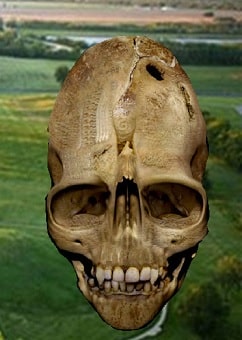Back in the 1920s a respected archaeologist named Julio C. Tello discovered a trove of what has been dubbed the Paracus Skulls.
His discovery confirmed the existence of the lost Paracas culture which inhabited coastal region of the Paracas peninsula of Peru from Circa 800BC to 100AD. The Paracus Penninsula is in the same general region as the Nasca Plain, for those familiar with the enigmatic Nasca lines
A fascinating aspect of the Paracus skulls is that they are elongated and appear non human, in fact some have suggested that they are 'Alien'.
The Scholarly consensus on such elongated skulls, which are found in many places globally is that the shape of the skulls is due to cranial modification at Human hands by head binding. Head Binding has been documented in the past. The modification is commonly done by tightly wrapping the head at a very early age and forcing it to grow into the longated ET style. In fact this practice is still done among some of Humanities more primitive tribes.
< 
However, analysis on the Paracas skulls showed that there were no indications of cranial modifications apparent, as is the case with other mummies found worldwide.
In fact, the skulls differed slightly from standard Human skulls in several minor respects. Researcher LA Marzulli stated 'There is a possibility that it might have been cradle headboarded, but the reason why I don't think so is because the position of the foramen magnum is back towards the rear of the skull. A normal foramen magnum would be closer to the jaw line' how the ancient Paracas people modified their bone structure in a fashion that no other culture could remains a mystery.
Genetic Analysis of the Skulls
On one of the skulls, the DNA results came back as unfamiliar - of unknown origins. The perplexing results prompted researchers to conduct additional testing on more skulls and many more produced the same results.
According to DNA analysis, the Paracus Skulls could either be alien or a heretofore unknown or at the very least undocumented twig on Humanities evolutionary tree.

David Hatcher Childress has postulated that elongated skulls are the product of contact between aliens at or before the peak of the Paracas culture. He believes that the Paracas skulls are the result of attempts by primitive humans to emulate their gods - who were actually alien visitors, or that the skulls are the remains of the actual aliens.
Alternative historian Brien Foerster was permitted by the Paracas History Museum to take samples from several skulls for analysis. They were given to Lloyd Pye, researcher of the Star Child skull. The Star child skull has been postulated to be an human/alien hybrid. Pye in turn passed them onto a Texas geneticist Dr Melba Ketchum, a Bigfoot researcher, who did the final analysis.
The test results showed that the skulls had mitochondrial DNA with mutations unknown in any human, primate, or animal. As per the researcher 'a few fragments I was able to sequence from this sample indicate that if these mutations will hold we are dealing with a new human-like creature, very distant from Homo sapiens, Neanderthals and Denisovans.'
Issues pointed out by opponents are that the results have no peer reviews, which is crucial in any scientific discovery. There is also the claim that the research lacks scientific objectivity. Scientific Objectivity is a value that informs how scientific studies are conducted and how scientific truths are arrived at. It is the idea that scientists, in attempting to uncover truths about the natural world, must aspire to eliminate personal biases, emotional involvement and so forth.
All researchers involved in this project so far - David Childress, Brien Foerster, Lloyd Pye [deceased], Melba Ketchum are alternative history proponents.
Childress makes a fortune off his related books, Foerster is an aspiring alternative history Author, Pye was an alternative history proponent as evidenced by his Star Child Skull research and Melba Ketchum for her work on Big foot.




